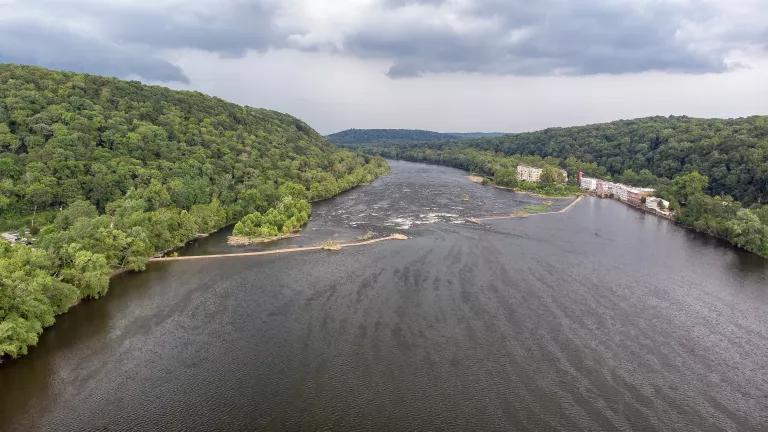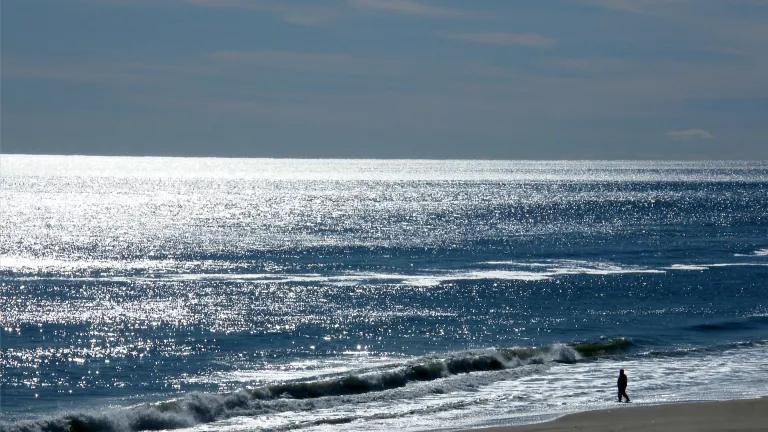Whale Strandings Emphasize a Need for Practical Solutions
Recent whale deaths highlight the need to limit vessel speeds, invest in ropeless fishing systems, and adopt responsible offshore wind.

Staff from area stranding network teams conduct a necropsy, or postmortem examination, of a stranded humpback whale in Brigantine, New Jersey on January 15, 2023.
Marine Mammal Stranding Center
Several humpback and sperm whales have washed ashore New York and New Jersey beaches in recent months, distressing communities left wondering why. Some have blamed America’s newest ocean use—offshore wind—for the deaths, proposing that noise associated with pre-construction surveys disorient whales and cause them to beach.
It’s true that ocean noise is a major environmental problem. High-intensity noise, like the seismic blasting that the oil and gas industry uses to prospect deep under the seafloor, can disturb marine mammals, fish, and other species over large areas of ocean, and noise from commercial shipping has created a constant din. But the sounds produced by offshore wind’s pre-construction surveys are much lower in energy than more powerful industrial sources, and tend to be highly directional, making it very unlikely that they drove the whales off New York and New Jersey to strand.
So, what has caused these deaths? It’s hard to say. What we do know is that along the East Coast, humpback whales have been experiencing what’s known as an Unusual Mortality Event, with elevated strandings, since 2016, and sperm whales—listed as endangered under the Endangered Species Act and as a depleted and strategic stock under the Marine Mammal Protection Act—have been experiencing elevated strandings in other parts of the world, including England and Tasmania, the reasons for which are also largely unclear.
For humpbacks, roughly 40 percent of necropsies carried out during the Unusual Mortality Event show harm from ship strike or entanglement. Unfortunately, this is not shocking as vessel strikes and entanglement in fishing gear eclipse all other direct human sources of mortality for most whales. Initial results from Marine Mammal Stranding Center scientists indicate that at least two of the humpback deaths in New Jersey probably stem from vessel strikes.
Other East Coast whales are also in trouble. Minke whales and North Atlantic right whales are also experiencing Unusual Mortality Events off the East Coast since 2017. Indeed, right whales are at imminent risk of extinction as a result of entanglement in fishing gear and vessel strikes. Necropsies of minke whales indicate that many animals are suffering from infectious disease or have been impacted by human interaction. All other large whale species found off the East Coast—blue whales, fin whales, and sei whales—are also listed as endangered, and are similarly impacted by human activities while struggling to recover from industrial whaling.
Underlying these threats is the specter of climate change. Ocean warming is changing the distribution of key prey species, and large whale distributions are also shifting as they track their prey. These shifts have brought whales into greater conflict with human activities like fishing and vessels in some instances and have made animals more susceptible to malnourishment and ill health in others.

A North Atlantic right whales breaches just a few feet away from a commercial ship. Vessels strikes are one of the main causes of the species decline towards extinction
What is crystal clear about the recent news is that it’s time to take practical and important actions to protect our whales:
- Science is unequivocal on the value of vessel speed restrictions in reducing deaths of large whale species and sea turtles from vessel collisions, and a 10-knot speed limit for all vessels would significantly reduce lethal ship strikes. NOAA’s recently proposed regulations to keep boats 35-feet or greater in length to 10
-knots in right whale habitat would meaningfully reduce vessel strike risk for North Atlantic right whales—a necessary move to save the species from extinction—and have ancillary benefits in protecting other large whales and turtles and reducing chronic ocean noise. NOAA should expeditiously approve its vessel speed rule, and work with its partner agencies to continue to pursue additional complementary measures, such as sector-specific vessel slow-downs, port incentive programs to encourage year-round speed reductions, and advancing near real-time monitoring programs and technologies to improve detections of whales out on the water. - Entanglement in vertical buoy lines associated with pot/trap fishing gear is a leading cause of death of critically endangered right whales. Entanglements are also a horrific animal welfare concern. Whales can drown almost immediately or develop excruciatingly painful wounds that ultimately result in an animal’s death weeks or months later. Entanglements also result in chronic stress, illness, and an impaired ability to successfully calve. To save the North Atlantic right whale and reduce entanglement risk for other whale species, we must significantly invest in transitioning the American lobster and Jonah crab fisheries to ropeless (on-demand) fishing systems in a way that avoids economic burden on fishermen. Ropeless fishing systems will virtually eliminate entanglements while keeping fishermen on the water and in business.
- We also need strong federal mitigation and monitoring requirements that protect whales and other wildlife while responsibly developing offshore wind. We need offshore wind and we need to do it right. Offshore wind can produce significant amounts of the clean, renewable energy we need to combat climate change. It’s generally stronger and more consistent than onshore wind, and can be built near major coastal cities, where more than half of the U.S. population lives and energy needs are high. We can and must ensure these wind farms are built and operated in a way that protects our ocean environment and wildlife.
Starting our important new U.S. offshore wind industry off strong with robust proactive protections in place helps ensure we protect our valuable and vulnerable wildlife, lessens the industry’s liability risk, and builds trust.
We don’t need to choose between clean energy development and wildlife protection. For example, South Fork Wind, which will power 70,000 homes and businesses in New York by the end of this year, recently adopted smart vessel speed protections and stronger mitigation and monitoring measures during noisy construction activities to help protect the critically endangered North Atlantic right whale.
We can protect the wildlife we love and advance offshore businesses responsibly. As we increasingly use our ocean, it’s abundantly clear that we need to take the steps we have on hand to protect whales and other species, and to fund the necessary research and monitoring to guide our decision-making.
For additional information, please see the February 2023 statement from the Marine Mammal Commission.





